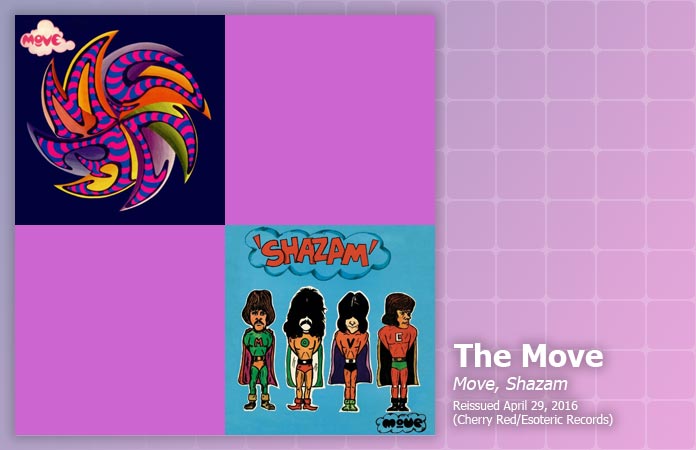Music Review: The Move, Move and Shazam (Reissues)
Published on August 2nd, 2016 in: Current Faves, Music, Music Reviews, Reissues, Retrovirus, Reviews |Though I’d always been a fan of “Dream Police” and “She’s Tight,” it wasn’t until 1993 that I fully embraced the many pleasures Cheap Trick had to offer. Checking the liner notes on their 1978 album Heaven Tonight revealed that amongst the album’s many fantastic tracks was a cover by someone named Roy Wood. “Who the hell was Roy Wood?” was my first thought and my second was “This song is incredible!” As it turned out Wood was the main songwriter for British band The Move, who’d found much success in the late 1960s and was a big influence on Cheap Trick’s musical style.
It would be a few more years before I purchased anything by The Move, a two-album vinyl compilation from 1981 that I scored at a record convention. It was nothing short of a revelation. How had this band slipped by me all these years? Eventually, I found the Movements 30th anniversary three-CD box set which had more previously-unheard gems.
Now Cherry Red and Esoteric Records have reissued the first two Move albums—Move and Shazam—in deluxe packages with photos, scanned press clippings, and oodles of bonus tracks (including BBC recordings, previously unreleased songs, and radio interviews with various members of the band) as well as informative and entertaining liner notes by Mark Paytress, written especially for the reissues.
Move is a breathtaking onslaught of pop perfection, giving many reasons why The Move were considered a singles band in the late ‘60s and indicating why moving away from that formula proved so difficult for them. There is not a dud amongst the album’s 13 tracks, which include ten Roy Wood originals and three covers. The first disc also includes two singles (and their B-sides): the band’s first from 1966, “Night of Fear” as well as their 1967 release, “I Can Hear the Grass Grow,” which is the song most folks will probably recognize (and was later covered by Jellyfish).
Disc two features stereo mixes—which are revelatory, especially on headphones—and alternate takes, all of which indicate that if there was any reason why The Move aren’t as well-known as their British peers it’s because there was simply too much talent to sustain them. With all five original band members contributing to vocals and song choices and Roy Wood’s distinctive writing style, it was likely difficult to pin them down to any one musical genre.
It was this tension that led to personnel changes and a two-year wait for the band’s next album, 1970’s Shazam, which contains only six songs. Despite Wood’s prodigious talents at coming up with catchy tunes, three of these tracks are covers. Overall, it’s a weirder and more challenging listen than Move but still incredibly rewarding, as the band lends their unique flavor to every tune, particularly the Wood-penned “Hello Susie,” which had already been released as a single by Welsh band Amen Corner in 1969.
The singles (and B-sides) for “Wild Tiger Woman” (why this song didn’t burn up the charts is a mystery), “Blackberry Way” (the only song to score a #1 for the band), and the oddly charming “Curly.” The first disc also includes alternate takes and unreleased tracks, including “Omnibus,” which in a perfect world, would have been a Top Ten single for the band.
Disc Two contains even more interesting covers such as “Another Piece of My Heart,” “Kentucky Woman,” “Goin’ Out of My Head,” “The Sound of Silence,” The Nazz’s “Open My Eyes,” and a perfectly hilarious version of The Beach Boys’ “California Girls.” While these are all fine and good, it’s clear that the band was struggling to maintain an identity at this point in their career and the eclectic assortment of material bears this out.
These two releases are an exhaustive account of the early years of The Move, before Jeff Lynne joined the band and they became a precursor to ELO. Fans of the band will definitely want to add these discs to their collection and for those who are looking to dip a toe into the muddy waters of The Move, they provide an excellent starting point not to mention verifiable proof of Roy Wood’s indelible stamp on pop music.
Move and Shazam were reissued by Cherry Red/Esoteric Records on April 29.

Time limit is exhausted. Please reload the CAPTCHA.